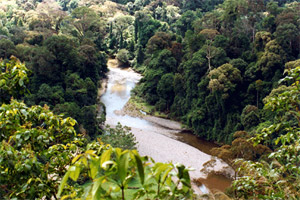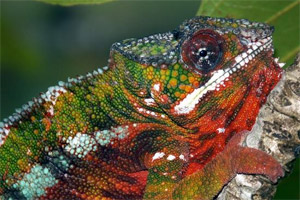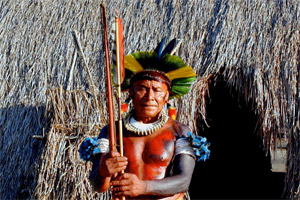What is Deforestation?
By Lisa Algee
Deforestation Lesson Plan
By Lisa Algee
Deforestation refers to the cutting, clearing, and removal of rainforest or related ecosystems into less bio-diverse ecosystems such as pasture, cropland, or plantations (Kricher, 1997).
What are the causes of deforestation?
I. Logging
II. Mining
III. Oil and gas extraction
IV. Cattle ranching
V. Agriculture: Cash crops
VI. Local, National, and International factors: development, land titles, government subsidies to attract corporations into developing countries, trade agreements (NAFTA, CAFTA), civil wars, debt, lack of resources, and lack of law enforcement.
Largest rainforests worldwide listed in descending order (from largest to smallest).
- Amazon basin of South America
- Congo river basin of Central Africa
- S.E. Asia
- New Guinea
Learn more about the world's largest rainforests.
- Did you know that tropical rainforests, which cover 6-7% of the earth's surface, contain over half of all the plant and animal species in the world!
- Did you know that 57% of all rainforests remaining are located in the Neotropics, with 30% located in Brazil.
Overview of deforestation around the world:
Between 1960 and 1990, most of the deforestation occurred globally, with an increasing trend every decade.
- Brazil has the highest annual rate of deforestation today.
- Atlantic coast of Brazil has lost 90-95% of its rainforest.
- Central America has 50% of its rainforests.
- South America has 70% of its rainforests.
- The Philippines have lost 90% of its rainforests!
- Madagascar has lost 95% of its rainforests!
- El Salvador has lost 70-85% of its rainforest due to heavy bombing during the civil war 1984-1985.
- Sumatra has 15% of its rainforests left.
- Only 6% of Central Africa's forests are protected by law.
Statistics on Global Rates of Rainforest Destruction:
2.4 acres (1 hectare) per second: equivalent to two U.S. football fields
149 acres (60 hectares) per minute
214,000 acres (86,000 hectares) per day: an area larger than New York City
78 million acres (31 million hectares) per year: an area larger than Poland
On average, 137 species become extinct everyday; or 50,000 each year!
*If the current rate of deforestation continues, the world's rain forests will vanish within 100 years- causing unknown effects on global climate and eliminating the majority of plant and animal species on the planet*
What are the consequences of deforestation?
Environmental:
- Extinctions (loss of biodiversity of microbes (bacteria), plants, insects, animals, indigenous peoples, etc.
- Habitat fragmentation. This disturbs the animals' habitat and may force them to enter habitats which are already occupied. This can pose many problems such as territorial conflicts, homelessness (loss of habitat), lack of food availability, migration disturbances, etc.
- Soil erosion occurs when trees and plants are removed; the rain water washes the nutrients in the top soil away.
- Changes in watershed geomorphology.
- Desertification (dry, hot, arid conditions).
- Edge effects can change microclimates (small climates) which affect endemic species (native species which can only live in specific environmental and habitat conditions).
- Climate change (more carbon dioxide is released into the atmosphere, thus increasing the effects of global warming).
- Pollution (ground, water and air pollution from oil extraction and mining chemicals).
Social impacts:
- Loss of culture (indigenous peoples subsistence living in the rainforest). People who live in the rainforest depend on the natural environment for food, shelter, materials for cooking, clothing, etc. If the forest is cut down or if their environment becomes polluted from oil extraction and mining, they are forced to move or risk starvation and sickness.
- Displacement of people (loss of farmland, forest resources, etc).
- Social conflicts and struggles over land and natural resources.
- Conflicts over racial and ethnic rights.
- Poisoning from oil and mining waste.
- Economic uncertainty (price fluctuations and high interest rates on outstanding international loans with The World Bank and International Monetary Fund.
What can we do to STOP or at least lessen the amount of deforestation and conserve our own use of natural resources such as wood, oil and gas, electricity, minerals and elements, and water? Brainstorm...here's a start:
- Always use both sides of paper when writing, drawing, photo-copying, faxing, etc.
- Recycle paper, cans, glass, and plastic.
- Read the newspaper on-line.
- Buy paper products made from recycled paper: notebook paper, paper towels, toilet paper, books, etc.
- Use pencils until they are stubs! Think of pencils as gold (you'll never lose them if you do).
- Encourage your parents, relatives, and friends to buy furniture and wood that is Certified. That means the wood was legally cut-down.
- If you buy a product and you notice they use wood chips to package it, write to the company and suggest they use another packaging material.
- Trees get cut down for cattle to graze. Instead of eating meat, think of eating other sources of protein such as fish, soy, beans, whole-wheat, and nuts.
- Buy organic fruits and vegetables. That means there are no insecticides or pesticides (poisonous chemicals) sprayed on the food. If these chemicals kill insects and pests that try and eat the vegetables, think about how harmful they can be to you and the environment.
- Instead of buying gold or diamonds, which are mined and cause environmental damage, consider jewelry that is made from materials that are not mined...such as glass.
- Encourage your parents, relatives, and friends to drive fuel efficient cars that get good gas mileage. Hybrid and bio-diesel cars get great mileage and use less or no gasoline.
- Even better, whenever possible, walk, bike, carpool or use mass transit (bus or train).
- Save electricity by turning off lights, t.v., radio, computer, etc when you are not using them.
- Save water by NOT taking baths; instead take quick showers (turning off the water while you soap up) and then turning it back on to rinse quickly.
- While washing your hands and brushing your teeth, turn off the water. You'll save gallons if you do.
- When washing the dishes or your parent's car, turn off the water while washing it with soap. Rinse quickly after washing.
- Hmmm, can you think of other ways to conserve wood, oil and gas, electricity, minerals and elements, and water, etc...? Brainstorm with your pen pal or a family member.
Okay, now show YOURSELF what you have LEARNED by answering the following questions:
- What does deforestation mean? (Hint: The prefix de- means to remove or reduce).
2. Why does deforestation happen? For what purpose(s)?
3. The largest rainforest in the world is located in:
a.) The Philippines
b.) The Congo Basin in Central Africa
c.) Peru
d.) The Amazon Basin of South America
4. If 2 U.S. football fields are destroyed every second, how many football fields are destroyed in 5 seconds?
5. If 50,000 species become extinct every year, how many will become extinct in half a year?
6. T or F: Rainforests contain over half of all plant and animal species in the world?
7. Fill in the blank: One environmental consequence of deforestation is __________. This occurs when heavy rains wash nutrients from the soil.
8. Name two things you can do as a global citizen to decrease deforestation.
9. Biodiversity refers to:
a.) The loss of animals and plants
b.) A variety, or many different kinds of living things
c.) When animals lose their living space or habitat
d.) An increase in the earth's temperature
10. Fill in the blank: Indigenous people _______ in the rainforest. They depend on the forest for their food, clothing, medicine, cooking and building materials.
Deforestation photos taken by Mongabay founder Rhett A. Butler
Chevron's Duri oil field in Riau
Deforestation for oil palm
Newly planted oil palm plantation
Smoke rising from a forest fire in Riau
Soy and Chaco forest
Deforestation in Riau
Smallholder deforestation
Illegal clearing and burning inside Tesso Nilo
Peatlands destruction in Riau
Smallholder deforestation in Borneo
Illegal sand and gold mining
Smallholder deforestation in Borneo
Deforestation for oil palm
Drained, cleared, and burned peatland and forest
Batu Hijau mine
Smallholder deforestation in Borneo
Industrial logging in Malaysian Borneo
Illegal sand and gold mining
Oil palm estate and rainforest in Malaysian Borneo
Deforestation for oil palm
Deforestation for oil palm
Chaco forest recently destroyed for soybeans
Illegal deforestation for palm oil
Burning within Tesso Nilo National Park
Smallholder deforestation in Borneo
Haze rising from an oil palm plantation and forest in Riau
Stacks of rainforest timber in Indonesia
Logging truck in Borneo
Deforestation in Riau
Deforestation in Sumatra
Brush fire in the Ngorongoro Conservation Area
Burned peat forest
New oil palm plantation established on peatland outside Palangkaraya
deforestation for oil palm
Smallholder deforestation in Borneo
Bulldozer at a conventional logging site in Borneo
Acacia plantation
Overhead view of the Rio Huaypetue gold mine the Peruvian Amazon
Rainforest timber transported in lagoon near Loango National Park in Gabon
Sunset over a deforested area
Drained, cleared, and burned peatland and forest
Peat forest cleared for palm oil
Answers are located after the references (please don't look until you have completed all 10 questions).
Pen Pal Letter: Imagine you're in class and your teacher reads an article about a U.S. company which is deforesting a rainforest in Brazil. Your teacher encourages you and your classmates to write letters to the company. Using the information you have learned in this lesson, write your letter to convince the company to STOP the deforestation. Use the facts you have learned to support and provide evidence for your position. Write your letter in the Comments Section after this lesson. You and your Pen Pal will read each other's letters and provide positive feedback to each other.
References:
Kricher, J. (1997). A Neotropical Companion: An introduction to the animals, plants, & ecosystems of the New World Tropics. New Jersey: Princeton University Press.
Rainforest Action Network web-site: https://ran.org/info_center/factsheets/04b.html
NASA web-site: https://eospso.gsfc.nasa.gov/ftp_docs/Deforestation.pdf
Answers to questions:
1. Deforestation refers to the cutting, clearing, and removal of rainforest or related ecosystems into less bio-diverse ecosystems such as pasture, cropland, or plantations.
2. Logging, mining, oil and gas extraction, cattle ranching, agriculture, and International, National, and Local reasons.
3. d.) The Amazon Basin in South America
4. 2 U.S. football field= 1 second, then
? U.S. football fields= 5 seconds
You can set it up as a proportion: 2/1= n/5, n=10
5. 1/2 of 50,000 or 1/2 x 50,000 or 50,000/2= 25,000 species
6. True
7. erosion
8. Buy paper products made from recycled paper and become a vegetarian
9. b.) A variety, or many different kinds of living things
10. live
How did you do? I bet you did great!
Note: This integrated lesson is designed for 3rd grade students. The following California standards are addressed in this lesson:
Reading: Vocabulary and Concept Development (1.6): Use sentence and word context to find the meaning of unknown words.
Reading Comprehension: Comprehension and Analysis of Grade-Level-Appropriate Text (2.6): Extract appropriate and significant information from the text, including problems and solutions.
Writing applications: Write personal and formal letters , thank-you notes, and invitations (2.3): Show awareness of the knowledge and interests of the audience and establish a purpose and context.
Life Science: Students know when the environment changes, some plants and animals survive and reproduce; others die or move to new locations.
Social Studies: Students understand the role of rules and laws in our daily lives and the basic structure of the U.S. government (3.42): Discuss the importance of public virtue and the role of citizens, including how to participate in a classroom, in the community, and in civic life.
Algebra and Functions: Students select appropriate symbols, operations, and properties to represent, describe, simplify, and solve simple number relationships: (1.1): Represent relationships of quantities in the form of mathematical expressions, equations, or inequalities.
Content on deforestation for younger readers
Deforestation news
FAQs
- May I use graphics from mongabay.com for my projects? Yes, you may provided that you don't remove the mongabay label from the images. You may use information from the site for class projects and can cite mongabay as the source.
- Where can I learn more about rainforests? Check the main rainforest site.
- Is this web site credible? Mongabay is the world's most popular source for information on tropical forests. The site is highly acclaimed by a number of the world's leading tropical scientists. See more answers at our frequently asked questions page.












